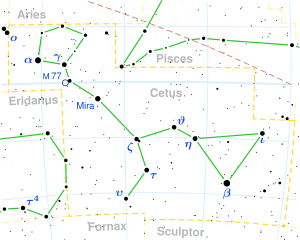Lambda Ceti
Lambda Ceti, Latinized from λ Ceti, is B-type star of fifth-magnitude located in the constellation Cetus. Historically, the star bore the traditional name Menkar, although today that name is more commonly associated with α Ceti.
| Observation data Epoch J2000 Equinox J2000 | |
|---|---|
| Constellation | Cetus |
| Right ascension | 02h 59m 42.900s[1] |
| Declination | 08° 54′ 26.49″[1] |
| Apparent magnitude (V) | 4.6767 |
| Characteristics | |
| Spectral type | B6III[2] |
| U−B color index | -0.45 |
| B−V color index | -0.12 |
| Astrometry | |
| Radial velocity (Rv) | 10.2[2] km/s |
| Proper motion (μ) | RA: 6.01 ± 0.26[1] mas/yr Dec.: –17.70 ± 0.29[1] mas/yr |
| Parallax (π) | 5.66 ± 0.24[1] mas |
| Distance | 580 ± 20 ly (177 ± 7 pc) |
| Absolute magnitude (MV) | -1.52[3] |
| Details | |
| Mass | ~4.6[4] M☉ |
| Radius | 5.4[4] R☉ |
| Luminosity | 652[3] L☉ |
| Temperature | 13,940 ± 710[5] K |
| Rotational velocity (v sin i) | 150[6] km/s |
| Age | 100-125[4] Myr |
| Other designations | |
| Database references | |
| SIMBAD | data |
This star, along with α Cet (Menkar), γ Cet (Kaffaljidhma), δ Cet, μ Cet, ξ1 Cet and ξ2 Cet were Al Kaff al Jidhmah, "the Part of a Hand".[7]
In Chinese, 天囷 (Tiān Qūn), meaning Circular Celestial Granary, refers to an asterism consisting of λ Ceti, α Ceti, κ1 Ceti, μ Ceti, ξ1 Ceti, ξ2 Ceti, ν Ceti, γ Ceti, δ Ceti, 75 Ceti, 70 Ceti, 63 Ceti and 66 Ceti. Consequently, the Chinese name for λ Ceti itself is 天囷三 (Tiān Qūn sān, English: the Third Star of Circular Celestial Granary.)[8]
Properties
Lambda Ceti is a blue giant star with stellar classification B6III. With a mass between 4.5-4.8 M☉ and an estimated radius that is 5.4 R☉, the star radiates a bolometric luminosity of about 920 L☉.[4] In 1997 the Hipparcos satellite estimated its parallax at 7.69 ± 0.76 milliarcseconds yielding a distance from Earth of about 130 ± 10 parsecs or 420 ± 40 light years. However recent astrometric calculations by van Leeuwen have placed the distance much farther at about 177 ± 7 pc or 580 ± 20 ly—a revaluation which significantly altered other stellar parameters.[1] Its apparent magnitude has been recently recalibrated at 4.6767 yielding an absolute magnitude of -1.56, almost as bright as its neighbor Alpha Ceti at -1.62.
See also
- Lists of stars in the constellation Cetus
- Class B Stars
- Giant star
References
- van Leeuwen, F. (2007). "Validation of the new Hipparcos reduction". Astronomy and Astrophysics. 474 (2): 653–664. arXiv:0708.1752. Bibcode:2007A&A...474..653V. doi:10.1051/0004-6361:20078357.Vizier catalog entry
- "* lam Cet". SIMBAD. Centre de données astronomiques de Strasbourg. Retrieved 2010-09-30.
- Anderson, E.; Francis, Ch. (2012), "XHIP: An extended hipparcos compilation", Astronomy Letters, 38 (5): 331, arXiv:1108.4971, Bibcode:2012AstL...38..331A, doi:10.1134/S1063773712050015.
- Professor James B. (Jim) Kaler. "LAMBDA CET (Lambda Ceti, the former "Menkar")". University of Illinois. Retrieved 2010-09-30.
- Zorec, J.; et al. (2009). "Fundamental parameters of B supergiants from the BCD system. I. Calibration of the (λ_1, D) parameters into Teff". Astronomy and Astrophysics. 501 (1): 297–320. arXiv:0903.5134. Bibcode:2009A&A...501..297Z. doi:10.1051/0004-6361/200811147.
- "Bright Star Catalogue (Hoffleit+, 1991)". VizieR (5th Revised ed.). Centre de Données astronomiques de Strasbourg. Retrieved 2010-09-30.
- Star Name - R.H. Allen p.160
- (in Chinese) AEEA (Activities of Exhibition and Education in Astronomy) 天文教育資訊網 2006 年 7 月 11 日
External links
- Jim Kaler's Stars, University of Illinois: LAMBDA CET (Lambda Ceti, the former "Menkar")
